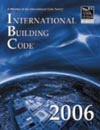| SECTION 1406 COMBUSTIBLE MATERIALS
ON THE EXTERIOR SIDE OF EXTERIOR WALLS
1406.1 General. Section
1406 shall apply to exterior wall coverings; balconies and
similar projections; and bay and oriel windows constructed
of combustible materials.
1406.2
Combustible exterior wall coverings. Combustible exterior
wall coverings shall comply with this section.
Exception: Plastics complying
with Chapter 26.
1406.2.1 Ignition resistance.
Combustible exterior wall coverings shall be tested in accordance
with NFPA 268.
Exceptions:
1. Wood or wood-based products.
2. Other combustible materials covered with an exterior
covering other than vinyl sidings listed in Table
1405.2.
3. Aluminum having a minimum thickness of 0.019 inch
(0.48 mm).
4. Exterior wall coverings on exterior walls of Type
V construction.
1406.2.1.1 Fire separation
5 feet or less. Where installed on exterior walls
having a fire separation distance of 5 feet (1524 mm)
or less, combustible exterior wall coverings shall not
exhibit sustained flaming as defined in NFPA 268.
1406.2.1.2 Fire separation
greater than 5 feet. For fire separation distances
greater than 5 feet (1524 mm), an assembly shall be permitted
that has been exposed to a reduced level of incident radiant
heat flux in accordance with the NFPA 268 test method
without exhibiting sustained flaming. The minimum fire
separation distance required for the assembly shall be
determined from Table 1406.2.1.2
based on the maximum tolerable level of incident radiant
heat flux that does not cause sustained flaming of the
assembly.
1406.2.2
Architectural trim. In buildings of Type I, II, III
and IV construction that do not exceed three stories or
40 feet (12 192 mm) in height above grade plane, exterior
wall coverings shall be permitted to be constructed of wood
where permitted by Section 1405.4
or other equivalent combustible material. Combustible exterior
wall coverings, other than fire-retardant-treated wood complying
with Section 2303.2 for exterior
installation, shall not exceed 10 percent of an exterior
wall surface area where the fire separation distance is
5 feet (1524 mm) or less. Architectural trim that exceeds
40 feet (12 192 mm) in height above grade plane shall be
constructed of approved noncombustible materials and shall
be secured to the wall with metal or other approved noncombustible
brackets.
1406.2.3
Location. Where combustible exterior wall covering is
located along the top of exterior walls, such trim shall
be completely backed up by the exterior wall and shall not
extend over or above the top of exterior walls.
1406.2.4
Fireblocking. Where the combustible exterior wall covering
is furred from the wall and forms a solid surface, the distance
between the back of the covering and the wall shall not
exceed 1.625 inches (41 mm) and the space thereby
created shall be frreblocked in accordance with Section
717.
1406.3
Balconies and similar projections. Balconies and similar
projections of combustible construction other than fire-retardant-treated
wood shall be fire-resistance rated in accordance with Table
601 for floor construction or shall be of Type IV construction
in accordance with Section 602.4.
The aggregate length shall not exceed 50 percent of the building's
perimeter on each floor.
Exceptions:
1.
On buildings of Type I and II construction, three stories
or less in height, fire-retardant-treated wood shall be
permitted for balconies, porches, decks and exterior stairways
not used as required exits.
2.
Untreated wood is permitted for pickets and rails or similar
guardrail devices that are limited to 42 inches (1067 mm)
in height.
3.
Balconies and similar projections on buildings of Type III,
IV and V construction shall be permitted to be of Type V
construction, and shall not be required to have a fire-resistance
rating where sprinkler protection is extended to these areas.
4.
Where sprinkler protection is extended to the balcony areas,
the aggregate length of the balcony on each floor shall
not be limited.
1406.4
Bay windows and oriel windows. Bay and oriel windows shall
conform to the type of construction required for the building
to which they are attached.
Exception:
Fire-retardant-treated wood shall be permitted on buildings
three stories or less of Type I, II, III and IV construction.
|

